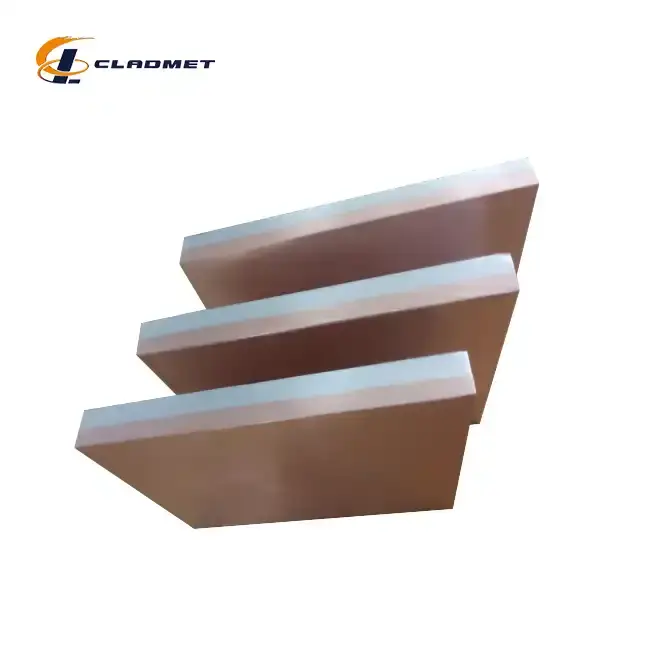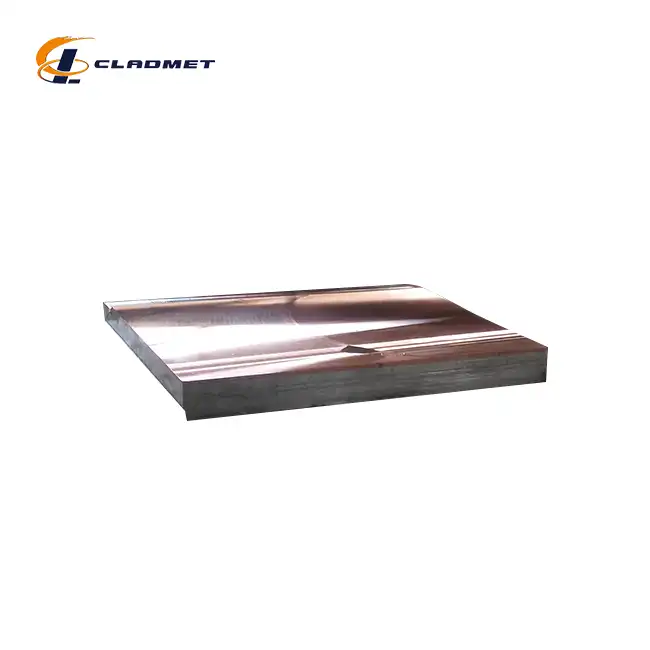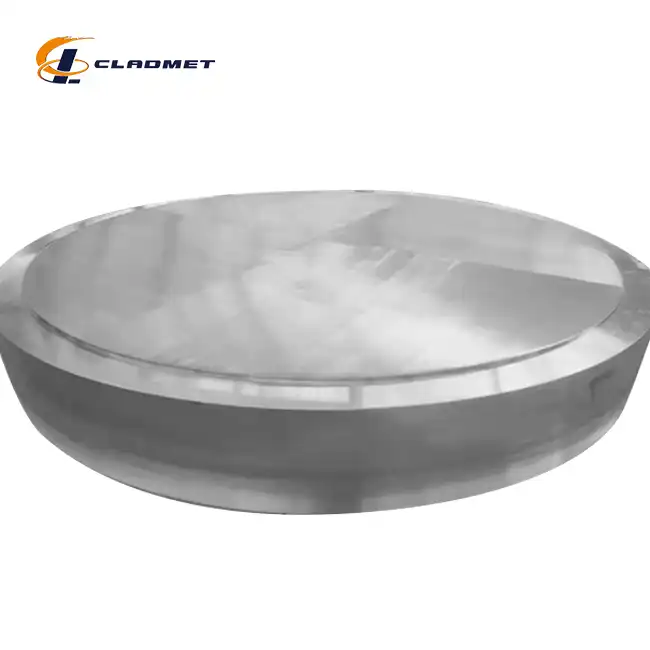How Do Aluminum Copper Clad Plates Enhance Thermal Efficiency in Industrial Settings?
 2025-07-11 09:38:02
View:389
2025-07-11 09:38:02
View:389In today's rapidly evolving industrial landscape, thermal management has become a critical factor in determining operational efficiency and cost-effectiveness. Among the innovative materials revolutionizing heat transfer applications, aluminum copper clad plates stand out as exceptional solutions that combine the best properties of both metals. These advanced bimetallic materials offer unparalleled thermal conductivity while maintaining structural integrity and cost efficiency. The aluminum copper clad plate represents a breakthrough in materials engineering, utilizing sophisticated manufacturing techniques such as explosion welding (EXW) to create seamless bonds between aluminum and copper layers. This unique combination addresses the growing demand for lightweight yet highly conductive materials in industries ranging from power generation to chemical processing, where thermal efficiency directly impacts productivity and profitability.

Superior Heat Transfer Properties of Aluminum Copper Clad Materials
Fundamental Thermal Conductivity Characteristics
The thermal efficiency of aluminum copper clad plates stems from copper's exceptional heat transfer capabilities, which are among the highest of all metals at approximately 385 W/mK. When bonded with aluminum through advanced explosive welding techniques, the resulting aluminum copper clad plate maintains copper's superior thermal conductivity while benefiting from aluminum's lightweight properties. This combination creates a material that can efficiently transfer heat across its surface while reducing overall system weight by up to 50% compared to solid copper alternatives. The metallurgical bond achieved through explosion welding ensures that thermal energy flows seamlessly between the copper and aluminum layers without resistance at the interface. Industries utilizing heat exchangers, thermal management systems, and cooling applications have reported significant improvements in heat transfer rates when switching to aluminum copper clad plates, with some applications showing efficiency gains of 15-25% over traditional materials.
Enhanced Surface Area and Heat Distribution
The unique structure of aluminum copper clad plates allows for optimized heat distribution across larger surface areas, making them ideal for applications requiring uniform temperature control. The aluminum layer provides excellent formability, enabling the creation of complex geometries and extended surface areas that maximize heat exchange potential. This characteristic is particularly valuable in industrial heat exchangers where the aluminum copper clad plate can be formed into intricate fin structures or corrugated patterns that significantly increase the effective heat transfer surface. The copper layer ensures that heat is rapidly conducted to all areas of the extended surface, preventing hot spots and ensuring uniform temperature distribution. Manufacturing facilities using these materials in their thermal management systems have observed reduced temperature variations and improved process control, leading to higher product quality and reduced energy consumption.
Rapid Heat Response and Thermal Cycling Performance
Industrial applications often require materials that can respond quickly to temperature changes and withstand repeated thermal cycling without degradation. Aluminum copper clad plates excel in these demanding conditions due to their optimized thermal mass and conductivity combination. The relatively low thermal mass of the aluminum layer allows for rapid heating and cooling responses, while the copper layer provides the necessary thermal conductivity to maintain efficient heat transfer throughout the cycling process. This performance characteristic is crucial in applications such as industrial heating elements, temperature control systems, and thermal processing equipment where precise temperature control and rapid response times are essential. Extended testing has demonstrated that aluminum copper clad plates maintain their thermal performance characteristics even after thousands of thermal cycles, making them reliable choices for continuous industrial operations.
Manufacturing Advantages and Process Optimization
Advanced Bonding Technologies and Quality Assurance
The manufacturing of aluminum copper clad plates involves sophisticated bonding technologies that ensure optimal thermal performance and structural integrity. Explosion welding (EXW) technology, utilized by leading manufacturers like Baoji JL Clad Metals Materials Co., Ltd., creates a metallurgical bond at the atomic level between aluminum and copper surfaces. This process involves precisely controlled explosive charges that force the materials together at extremely high velocities, creating an interfacial bond that is stronger than either parent material. The resulting aluminum copper clad plate exhibits superior thermal conductivity across the bonded interface, with no thermal resistance barriers that might impede heat transfer. Quality control measures ensure that each plate meets stringent standards including ISO9001-2000 certification, PED qualification, and ABS international certification, guaranteeing consistent thermal performance in industrial applications.
Customization Capabilities for Specific Thermal Requirements
Modern industrial applications often require specific thermal performance characteristics that can only be achieved through customized material solutions. Aluminum copper clad plates can be manufactured with varying thickness ratios between the aluminum and copper layers to optimize thermal performance for specific applications. Manufacturers can adjust the copper layer thickness from 0.5mm to 20mm, with widths up to 2500mm and custom lengths based on application requirements. This flexibility allows engineers to specify materials that provide the exact thermal conductivity needed while maintaining optimal weight and cost characteristics. The customization extends to surface treatments including smooth, brushed, or polished finishes that can further enhance thermal performance in specific applications. Industries such as aerospace, automotive, and power generation benefit significantly from these customization capabilities, as they can obtain materials precisely tailored to their thermal management requirements.
Cost-Effective Production and Scalability
The manufacturing process for aluminum copper clad plates offers significant cost advantages compared to solid copper alternatives while maintaining superior thermal performance. By utilizing aluminum as the substrate material and applying copper only where needed for thermal conductivity, manufacturers can reduce material costs by 30-40% while achieving comparable or superior thermal efficiency. The explosion welding process is highly scalable, allowing for production of large quantities without compromising quality or thermal performance characteristics. Roll bonding and hot isostatic pressing (HIP) techniques provide additional manufacturing options that can be selected based on specific application requirements and production volumes. This manufacturing flexibility ensures that aluminum copper clad plates remain cost-effective solutions even for large-scale industrial installations where thermal efficiency is critical to operational success.

Industrial Applications and Performance Benefits
Power Generation and Electrical Systems
In power generation facilities, thermal management is crucial for maintaining equipment efficiency and preventing costly downtime. Aluminum copper clad plates have found extensive applications in electrical systems where they serve as heat sinks, bus bars, and thermal interface materials. The combination of copper's excellent electrical conductivity with aluminum's lightweight properties makes these materials ideal for high-current applications where heat generation is significant. Power plants utilizing aluminum copper clad plates in their electrical systems have reported improved thermal management, reduced maintenance requirements, and enhanced overall system reliability. The materials' ability to handle high thermal loads while maintaining structural integrity makes them particularly valuable in applications such as transformer cooling systems, generator components, and power distribution equipment where thermal efficiency directly impacts power output and system longevity.
Chemical Processing and Heat Exchanger Applications
Chemical processing industries require materials that can withstand corrosive environments while maintaining excellent thermal transfer properties. Aluminum copper clad plates excel in these demanding applications due to their inherent corrosion resistance and superior thermal conductivity. The materials are widely used in heat exchangers, distillation columns, and chemical reactors where precise temperature control is essential for process efficiency and product quality. The seamless bond between aluminum and copper layers ensures that there are no weak points where corrosion might initiate, while the thermal properties enable efficient heat transfer even in challenging chemical environments. Processing facilities using aluminum copper clad plates have achieved significant improvements in energy efficiency, with some installations reporting energy savings of 20-30% compared to traditional materials.
Automotive and Transportation Thermal Management
Modern automotive and transportation systems require increasingly sophisticated thermal management solutions to handle the heat generated by advanced powertrains and electronic systems. Aluminum copper clad plates provide ideal solutions for applications such as electric vehicle battery cooling systems, engine heat exchangers, and electronic component thermal management. The lightweight nature of these materials contributes to overall vehicle weight reduction while ensuring optimal thermal performance. Automotive manufacturers have incorporated aluminum copper clad plates into radiators, oil coolers, and HVAC systems, achieving improved fuel efficiency and enhanced performance. The materials' ability to maintain thermal efficiency across a wide temperature range makes them particularly valuable in automotive applications where operating conditions can vary significantly.
Conclusion
Aluminum copper clad plates represent a transformative solution for industrial thermal management challenges, combining copper's exceptional thermal conductivity with aluminum's lightweight and cost-effective properties. Through advanced manufacturing techniques including explosion welding, these materials deliver superior heat transfer performance while offering significant advantages in weight reduction, cost efficiency, and application versatility. Industries ranging from power generation to chemical processing have realized substantial benefits from implementing aluminum copper clad plates, including improved energy efficiency, reduced maintenance costs, and enhanced operational reliability. As industrial demands for thermal efficiency continue to grow, these innovative materials position themselves as essential components for next-generation thermal management systems.
Ready to enhance your industrial thermal efficiency with premium aluminum copper clad plates? Baoji JL Clad Metals Materials Co., Ltd. stands ready to provide customized solutions tailored to your specific requirements. With over 20 years of expertise in clad metals manufacturing, our independent explosive composite technology, international certifications, and comprehensive OEM/ODM services ensure you receive materials that exceed industry standards. Our commitment to innovation, quality, and customer satisfaction makes us the ideal partner for your thermal management needs. Whether you require standard specifications or completely customized solutions, our experienced team will work with you to develop materials that optimize your thermal efficiency and operational performance. Contact us today at sales@cladmet.com to discuss your aluminum copper clad plate requirements and discover how our advanced materials can transform your industrial applications.
References
1. Davis, J.R., ASM Specialty Handbook: Heat-Resistant Materials, ASM International, Materials Park, OH, 1997.
2. Lienhard, J.H., A Heat Transfer Textbook, 4th Edition, Dover Publications, New York, 2008.
3. Crossland, B., Explosive Welding of Metals and Its Application, Oxford University Press, Oxford, 1982.
4. Kahraman, N., Gulenc, B., and Findik, F., "Joining of Titanium/Stainless Steel by Explosive Welding and Effect on Interface," Journal of Materials Processing Technology, Vol. 169, 2005.

_1737007724117.webp)
_1736996330512.webp)









